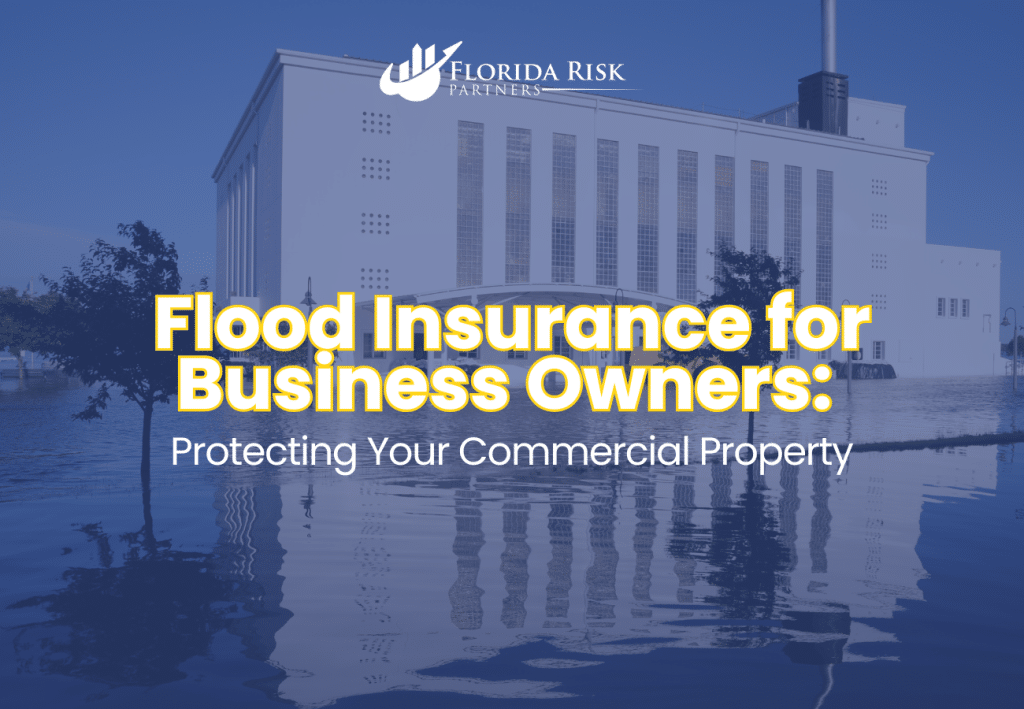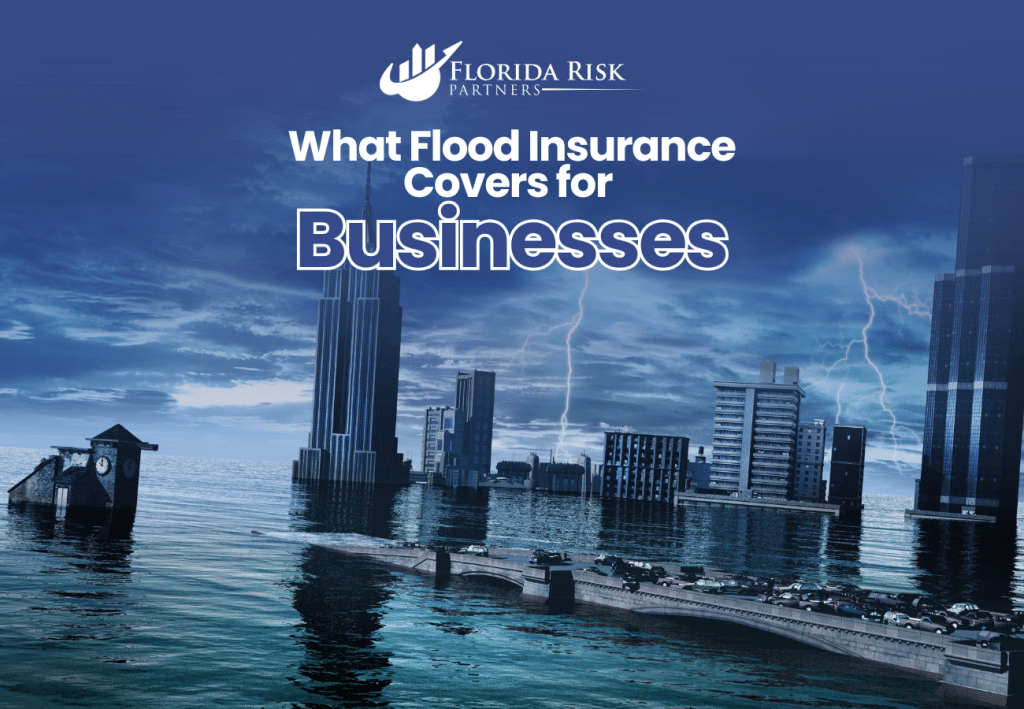-
Main Office: 1434 E. Bloomingdale Ave Valrico, FL 33596-6110
-
Phone: (888) 601-6660
-
Email: info@floridariskpartners.com

When it comes to running a business, ensuring the safety and continuity of your operations is paramount. One of the most overlooked yet critical aspects of risk management is flood insurance. Many business owners mistakenly believe that flooding won’t affect them, or worse, they assume their standard commercial property insurance will cover flood damage. The truth is, commercial property insurance typically does not cover flood damage, and if your business is located in a flood-prone area, this oversight could be financially devastating.
In this blog, we’ll discuss the importance of flood insurance for business owners, explain what flood insurance covers, and show you how to secure the right coverage for your commercial property. This post is part of our Flood Insurance 101 series, designed to help business owners and homeowners alike understand the essentials of flood insurance.
Why Business Owners Need Flood Insurance
Flooding can occur anywhere—whether your business is located in a high-risk coastal zone or an inland area with occasional heavy rains. According to the Federal Emergency Management Agency (FEMA), just 1 inch of floodwater can cause more than $25,000 in damage. For a business, this could mean ruined inventory, damaged equipment, and a temporary or even permanent halt to operations.
Flooding can happen unexpectedly, whether from hurricanes, flash floods, or even broken levees or drainage systems. In fact, more than 20% of flood claims come from properties located outside high-risk flood zones. If your business isn’t prepared with the right flood insurance, you could face catastrophic financial losses.
Even if you’ve taken steps to protect your business, such as installing drainage systems or elevating your property, there’s always a risk of flooding. This is why flood insurance is a must for business owners. Protecting your commercial property from flooding means safeguarding your livelihood. Learn more about flood insurance options here.
What Flood Insurance Covers for Businesses
Flood insurance for businesses typically provides two main types of coverage: building coverage and contents coverage. Let’s break down what these coverages include and why they’re essential for commercial properties.
1. Building Coverage
Building coverage protects the physical structure of your business property. This includes:
- The foundation of the building
- Electrical and plumbing systems
- HVAC equipment (heating, ventilation, and air conditioning)
- Permanently installed fixtures, machinery, and equipment
- Built-in appliances, such as refrigerators or walk-in freezers
For many businesses, the building itself is one of the most valuable assets. Without proper coverage, even minor flood damage could require costly repairs or rebuilding. If a significant flood event occurs, you may face massive repair costs and extended business interruption without building coverage.
FEMA’s National Flood Insurance Program (NFIP) provides commercial building coverage up to $500,000. For businesses that need higher coverage limits, private flood insurance policies are available. Explore what flood insurance covers for your business here.

2. Contents Coverage
Contents coverage is just as important as building coverage, as it protects the physical assets inside your business. This includes:
- Inventory and stock
- Furniture and fixtures
- Computers, servers, and other electronics
- Machinery and equipment not covered under building coverage
For retail stores, manufacturers, and restaurants, inventory and equipment represent a substantial portion of your business assets. A flood that damages or destroys these items could result in significant financial loss, especially if you don’t have contents coverage. For instance, a restaurant could lose its entire food supply and kitchen equipment, while a manufacturer might face replacing expensive machinery.
Like building coverage, contents coverage from the NFIP is capped at $500,000. If your business has a large inventory or specialized equipment, private flood insurance may offer more extensive coverage options. Learn more about flood insurance coverage for businesses here.
How Flood Insurance Premiums Are Determined for Businesses
The cost of flood insurance for businesses is influenced by several factors, including your property’s location, flood zone, and the type of coverage you need. Understanding how these factors affect your premiums can help you make informed decisions about protecting your business.
1. Flood Zone
FEMA designates flood zones based on the likelihood of flooding. Properties in high-risk flood zones, such as Zone A or Zone V, will have higher premiums due to the increased probability of flooding. Businesses located in moderate- to low-risk flood zones may have lower premiums, but it’s important to note that flooding can still occur in these areas.
Even if your business is located in a low-risk zone, securing flood insurance is a smart move. You can check your flood zone here to see your risk level and determine your potential insurance costs.
2. Building Characteristics
The construction, elevation, and age of your building also play a role in determining your flood insurance premiums. Buildings that are elevated above the base flood elevation (BFE) or constructed with flood-resistant materials often have lower premiums because they’re less likely to experience significant damage during the event.
Older buildings or those located below the BFE are at a higher risk of damage, resulting in higher premiums. Business owners who invest in flood mitigation strategies, such as elevating the property or installing flood barriers, may qualify for reduced premiums.

3. Coverage Limits and Deductibles
The amount of coverage you select for both building and contents protection will influence your premiums. Higher coverage limits provide more financial protection but come with higher premiums. Conversely, choosing a higher deductible (the amount you pay out of pocket in the event of a claim) can lower your premium, but it means taking on more financial responsibility if your business is flooded.
It’s important to strike a balance between adequate coverage and affordable premiums. To get an estimate of what flood insurance would cost for your commercial property, calculate your flood insurance premium here.
What Isn’t Covered by Flood Insurance?
While flood insurance is essential for protecting your business, it’s important to understand what it doesn’t cover. NFIP policies and many private insurance policies typically exclude:
- Business interruption coverage: It does not cover lost revenue if your business is forced to close due to flooding. However, some private insurers offer policies that include business interruption coverage, which can help cover lost income during the recovery period.
- Vehicles: If your business uses vehicles, such as delivery trucks or company cars, flood damage to these vehicles is not covered by flood insurance. You would need separate comprehensive auto insurance to cover flood-related vehicle damage.
- Outdoor property: Items like landscaping, fences, decks, and outdoor signage are not typically covered by flood insurance. You may need separate policies or riders to cover these features.
By understanding these exclusions, you can explore additional insurance options that will offer full protection for your business. Learn more about flood insurance coverage options here to see how you can ensure all aspects of your business are protected.
How to Purchase Flood Insurance for Your Business
Purchasing flood insurance for your business is a straightforward process, but it’s essential to understand the options available to you. The NFIP is a good starting point for most businesses, offering standard flood insurance coverage for both building and contents protection. However, if your business needs higher coverage limits or additional options like business interruption coverage, you may want to explore private flood insurance providers.
Here’s how to get started:
- Evaluate your flood risk: Use FEMA’s tools to determine your business’s flood zone and assess the likelihood of flooding. Check your flood zone here.
- Get a flood insurance quote: Contact your insurance provider or use an online tool to get a quote for your business. Be sure to compare quotes from both the NFIP and private insurers.
- Choose coverage options: Decide on the amount of building and contents coverage you need, along with your deductible. Consider additional coverage if necessary, such as business interruption insurance.
- Purchase your policy: Once you’ve selected the best policy for your business, work with your insurance agent to finalize your coverage. Keep in mind that flood insurance policies through the NFIP typically have a 30-day waiting period before coverage begins, so don’t wait until a storm is approaching to buy coverage.
Start your flood insurance purchase here and protect your business from the financial impact of flooding.
Flooding can happen anywhere and at any time, and the financial consequences for businesses can be devastating. Without flood insurance, business owners face the prospect of paying out of pocket for costly repairs, replacement of equipment and inventory, and even lost income.
By investing in the right flood insurance policy, you can protect your business from the unpredictable nature of floods and ensure that your operations can continue even after a disaster. Don’t wait until it’s too late—get your quote now here and safeguard your commercial property today.
Call Us Or
Schedule an Appointment
Select an agent below to view our online calendars and select a day and time that works best for you or call us directly at 888-601-6660. When you use our online calendars, you will receive an email with more information.



